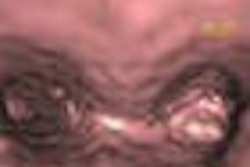Computer-aided detection (CAD) technology can yield favorable results in detecting lung nodules when used concurrently during the reading process, according to research from Kobe University Graduate School of Medicine in Japan.
"In this study of lung nodule detection at MDCT by the use of our prototype CAD system, the sensitivity, false-positive rate, and reading time of chest radiologists when using the system as concurrent reader were similar to those when using the system as a second reader," said Dr. Sumiaki Matsumoto, Ph.D.
While many studies have found CAD to improve the sensitivity of detecting lung nodules when used as a second reader, the technology might be better integrated into clinical workflow if it could be used at the same time the radiologist views the CT images, Matsumoto said. He presented the research during a session at the 2008 RSNA meeting in Chicago.
The study team sought to compare the performance of chest radiologists in lung nodule detection on MDCT scans when using a prototype CAD system first as a concurrent reader and then as a second reader.
Sixty MDCT datasets were included in the study, produced from either an Aquilion 16 or Aquilion 64 CT scanner (Toshiba Medical Systems, Tochigi, Japan) at 120 kVp, 150 mAs, 15 x 0.5 mm or 64 x 0.5 mm, and 0.94 or 0.84 beam pitch. Images were reconstructed with a 1-mm slice thickness and interval using a lung kernel.
The 60 studies contained 122 noncalcified nodules 4 mm or larger (as determined by a separate chest radiologist) and were read independently by three chest radiologists with 18, seven, and five years of experience, respectively. The radiologists first read the studies with CAD as a concurrent reader; four to six weeks later, the radiologists then read the same exams using CAD as a second reader.
The radiologists were asked to rate their findings for confidence level (0 = normal, 1 = definitely non-nodule but not normal, 2 = probably non-nodule, 3 = probably nodule, and 4 = definitely nodule) and follow-up action (0 = no need to follow up, 1 = follow-up at 12 months, 2 = follow-up at six months, and 3 = follow-up at three months at least or further workup and/or biopsy), according to Matsumoto. Findings with a confidence of 3 to 4 and follow-up of 1 to 3 were considered positive.
Sensitivity
|
The sensitivity differences were not statistically significant for any radiologist (p = 0.33, p = 0.75, and p = 0.77).
As for false positives, radiologist 1 had a mean of 0.7 with CAD as a concurrent reader and 0.88 with CAD as a second reader (p = 0.17). Radiologist 2 had a mean of 1.5 false positives with CAD as a concurrent reader and 1.47 with CAD as a second reader (p = 1.47), and radiologist 3 had a mean of 0.25 false positives with CAD as a concurrent reader and 0.3 with CAD as a second reader (p = 0.67).
The researchers also evaluated the reading time for each radiologist for both CAD approaches.
Reading time (seconds)
|
The differences were not statistically significant (p = 0.48, p = 0.41, and p = 0.43).
"Comparable results were found in sensitivity, false positives, and reading time," Matsumoto said.
By Erik L. Ridley
AuntMinnie.com staff writer
January 30, 2009
Related Reading
Lung CAD holds up well in low-dose MDCT studies, November 25, 2008
Researchers cut false positives in lung CAD, November 10, 2008
CAD detects more lung nodules but not necessarily more cancer, September 24, 2008
CAD steals show from U.S. research database, August 12, 2008
CAD helps residents identify lung nodules on DR, May 20, 2008
Copyright © 2009 AuntMinnie.com





















